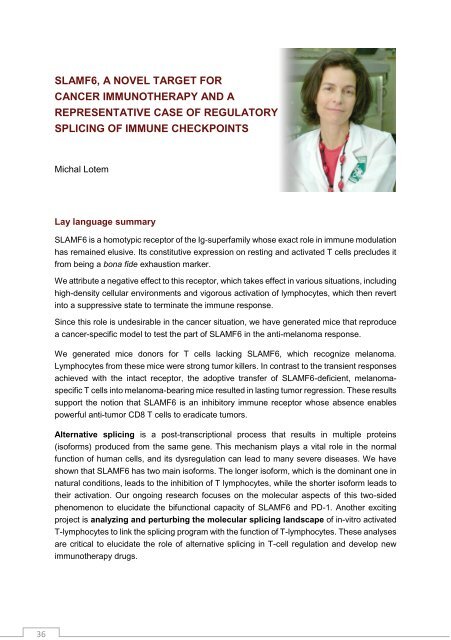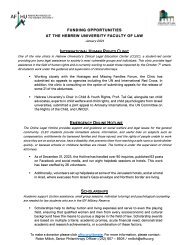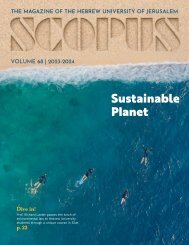SLAMF6, A NOVEL TARGET FOR CANCER IMMUNOTHERAPY AND A REPRESENTATIVE CASE OF REGULATORY SPLICING OF IMMUNE CHECKPOINTS Michal Lotem Lay language summary SLAMF6 is a homotypic receptor of the Ig-superfamily whose exact role in immune modulation has remained elusive. Its constitutive expression on resting and activated T cells precludes it from being a bona fide exhaustion marker. We attribute a negative effect to this receptor, which takes effect in various situations, including high-density cellular environments and vigorous activation of lymphocytes, which then revert into a suppressive state to terminate the immune response. Since this role is undesirable in the cancer situation, we have generated mice that reproduce a cancer-specific model to test the part of SLAMF6 in the anti-melanoma response. We generated mice donors for T cells lacking SLAMF6, which recognize melanoma. Lymphocytes from these mice were strong tumor killers. In contrast to the transient responses achieved with the intact receptor, the adoptive transfer of SLAMF6-deficient, melanomaspecific T cells into melanoma-bearing mice resulted in lasting tumor regression. These results support the notion that SLAMF6 is an inhibitory immune receptor whose absence enables powerful anti-tumor CD8 T cells to eradicate tumors. Alternative splicing is a post-transcriptional process that results in multiple proteins (isoforms) produced from the same gene. This mechanism plays a vital role in the normal function of human cells, and its dysregulation can lead to many severe diseases. We have shown that SLAMF6 has two main isoforms. The longer isoform, which is the dominant one in natural conditions, leads to the inhibition of T lymphocytes, while the shorter isoform leads to their activation. Our ongoing research focuses on the molecular aspects of this two-sided phenomenon to elucidate the bifunctional capacity of SLAMF6 and PD-1. Another exciting project is analyzing and perturbing the molecular splicing landscape of in-vitro activated T-lymphocytes to link the splicing program with the function of T-lymphocytes. These analyses are critical to elucidate the role of alternative splicing in T-cell regulation and develop new immunotherapy drugs. 36
37 Publications (2016 - <strong>2020</strong>): 1. Weinstein-Marom, H, Pato, A, Levin, N, Susid, K, Margalit, A, Peretz, T, Lotem M, and Gross, G. Membrane-attached cytokines expressed by mRNA electroporation act as potent T cell adjuvants. J Immunother. 2016 Feb-Mar;39(2):60-70 2. Moshe Sade-Feldman, Julia Kanterman, Amijai Saragovi, Hani Steinberg, Michal Lotem & Michal Baniyash*. Clinical significance of circulating CD33+CD11b+HLA-DR- myeloid cells in Stage IV melanoma patients treated with ipilimumab. Clin Cancer Res, 2016 Dec 1;22(23):5661-5672 3. Lotem M, Merims S, Frank S; Hamburger T; Nissan A; Kadouri L; Cohen J; Straussman R; Eisenberg G; Frankenburg S; Peretz T. Autologous melanoma vaccine for macroscopic stage III disease: adjuvant role, biomarkers and improved response to CTLA-4 blockade. J Immunol Res. 2016;2016:8121985 4. Engelstein R, Merims S, Eisenberg G, Cohen JE, Frank S, Hamburger T, Frankenburg S, Ron I, Isacson R, Grenader T, Steinberg H, Cohen CJ, Peretz T, Lotem M. Immune monitoring of patients treated with a whole-cell melanoma vaccine engineered to express 4-1BBL. J Immunother. 2016 Oct;39(8):321-8. 5. Cohen JE, Merims S, Frank S, Engelstein R, Peretz T, Lotem M. Adoptive cell therapy: past, present and future. Immunotherapy. 2017 Jan;9(2):183-196. 6. Levin N, Pato A, Cafri G, Eisenberg G, Peretz T, Margalit A, Lotem M, Gross G. Spontaneous Activation of Antigen-presenting Cells by Genes Encoding Truncated Homo- Oligomerizing Derivatives of CD40. J Immunother. 2017 Feb/Mar;40(2):39-50. 7. Zick A, Peretz T, Lotem M, Hubert A, Katz D, Temper M, Rottenberg Y, Uziely B, Nechushtan H, Meirovitz A, Sonnenblick A, Sapir E, Edelman D, Goldberg Y, Lossos A, Rosenberg S, Fried I, Finklstein R, Pikarsky E, Goldshmidt H. Treatment inferred from mutations identified using massive parallel sequencing leads to clinical benefit in some heavily pretreated cancer patients. Medicine (Baltimore). 2017 May;96(20):e6931 8. Senses KM, Ghasemi M, Akbar MW, Isbilen M, Fallacara AL, Frankenburg S, Schenone S, Lotem M, Botta M, Gure AO. Phenotype-based variation as a biomarker of sensitivity to molecularly targeted therapy in melanoma. Medchemcomm. 2017 Jan 1;8(1):88-95 9. Schachter J, Ribas A, Long GV, Arance A, Grob JJ, Mortier L, Daud A, Carlino MS, McNeil C, Lotem M, Larkin J, Lorigan P, Neyns B, Blank C, Petrella TM, Hamid O, Zhou H, Ebbinghaus S, Ibrahim N, Robert C. Pembrolizumab versus ipilimumab for advanced melanoma: final overall survival results of a multicentre, randomised, open-label phase 3 study (KEYNOTE-006). Lancet. 2017 Aug 16. pii: S0140-6736(17)31601-X 10. Jacquelot N, Roberti MP, Enot DP, Rusakiewicz S, Ternès N, Jegou S, Woods DM, Sodré AL, Hansen M, Meirow Y, Sade-Feldman M, Burra A, Kwek SS, Flament C, Messaoudene M, Duong CPM, Chen L, Kwon BS, Anderson AC, Kuchroo VK, Weide B, Aubin F, Borg C, Dalle S, Beatrix O, Ayyoub M, Balme B, Tomasic G, Di Giacomo AM, Maio M, Schadendorf D, Melero I, Dréno B, Khammari A, Dummer R, Levesque M, Koguchi Y, Fong L, Lotem M, Baniyash M, Schmidt H, Svane IM, Kroemer G, Marabelle A, Michiels S, Cavalcanti A, Smyth MJ, Weber JS, Eggermont AM, Zitvogel L. Predictors of responses to immune checkpoint blockade in advanced melanoma. Nat Commun. 2017 Sep 19;8(1):592
- Page 1 and 2: 1
- Page 3 and 4: MOLECULAR BASIS OF CARCINOGENESIS A
- Page 5 and 6: 5 19. Oster S, Aqeilan R.I. Mapping
- Page 7 and 8: 7 Publications (2016 - 2020): 1. Is
- Page 9 and 10: NEW THERAPEUTICS TO COMBAT ACUTE MY
- Page 11 and 12: 11 PhD students recently graduated:
- Page 13 and 14: 13 3. IL-17+ CD8+ T cell suppressio
- Page 15 and 16: A NOVEL ANTI-INFLAMMATORY PEPTIDE W
- Page 17 and 18: PROFILING PANCREATIC PREINVASIVE LE
- Page 19 and 20: HEPATIC INFLAMMATION AND METABOLISM
- Page 21 and 22: 21 11. Hanin G, Yayon N, Tzur Y, Ha
- Page 23 and 24: PREDICTION AND PREVENTION OF CONGEN
- Page 25 and 26: 25 12. Glasner A, Oiknine-Djian E,
- Page 27 and 28: 27 31. Alfi O, From I, Yakirevitch
- Page 29 and 30: NATURAL KILLER CELL FUNCTION IN PRE
- Page 31 and 32: 31 13. Obiedat A, Charpak-Amikam Y,
- Page 33 and 34: 33 33. Glasner A, Levi A, Enk J, Is
- Page 35: 35 Awards: The Rappaport Award for
- Page 39 and 40: 39 21. Emma Hajaj, Galit Eisenberg,
- Page 41 and 42: integrate these data and predict on
- Page 43: 43 Funding and Awards: 1. Concern F

















